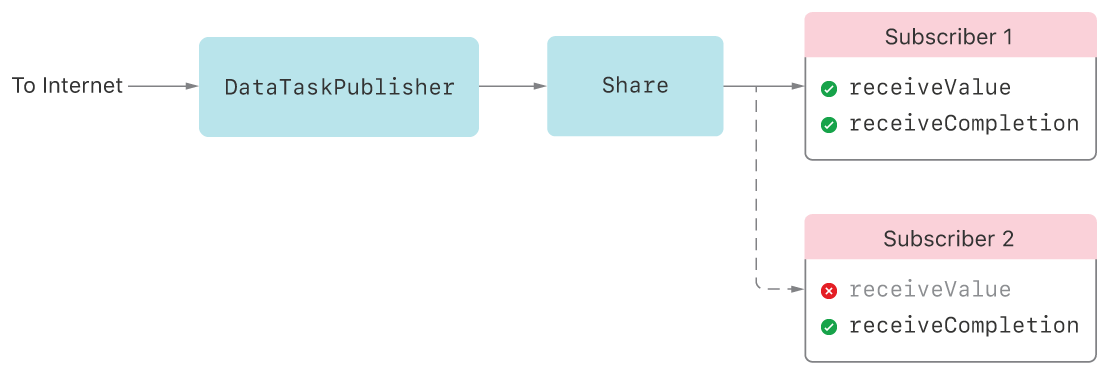Combine基础
- Publisher是发布者,作为数据生产者,会定义一个Output和Failure类型。
- Subscriber是订阅者,作为数据消费者,会定义一个Input合Failure类型。
- Operator是操作者,可以更改Publisher Output类型,产生新的Publisher。
- Publisher的Output类型和Subsciber的Input类型需要相同
订阅操作是通过
Publisher.subscribe(Subscriber)来完成的 获取到Subscribtion(Publisher.subscibe()返回)实例,可以调用.cancel()取消
sub?.cancel()
内置Subscriber
- sink(receiveCompletion:receiveValue:): 常用于publisher和sink一起执行的时候,比如request请求,返回的response会在sink中处理
-
assign(to
 ): 通过key path将收到的值赋值到model
): 通过key path将收到的值赋值到model
// publisher之后直接sink
let sub = NotificationCenter.default
.publisher(for: NSControl.textDidChangeNotification, object: filterField)
.sink(receiveCompletion: { print ($0) },
receiveValue: { print ($0) })
let sub = NotificationCenter.default
.publisher(for: NSControl.textDidChangeNotification, object: filterField)
.map( { ($0.object as! NSTextField).stringValue } )
.assign(to: \MyViewModel.filterString, on: myViewModel)
通过operator定制publisher
let sub = NotificationCenter.default
.publisher(for: NSControl.textDidChangeNotification, object: filterField)
.map( { ($0.object as! NSTextField).stringValue } )
// 过滤非字母和数字字符
.filter( { $0.unicodeScalars.allSatisfy({CharacterSet.alphanumerics.contains($0)}) } )
// 防抖
.debounce(for: .milliseconds(500), scheduler: RunLoop.main)
// receive方法可以让combine在指定线程里调用subscriber
.receive(on: RunLoop.main)
.assign(to:\MyViewModel.filterString, on: myViewModel)
share() operator
大多publishers都是struct, 是值类型,每一次订阅,实际上都是订阅了一个副本。share operator则可以赋予它们引用语义。
// PassthroughSubject是class类型,但是经过scan operator之后生成的是struct类型
let subject = PassthroughSubject<String, Never>()
// 这里每次emit value, 第一个参数都会累加
let publisher = subject.scan((0, ""), { ($0.0 + 1, $1) })
// subscribe一个
let c1 = publisher.sink { print("c1:", $0) }
subject.send("a")
subject.send("b")
// output
c1: (1, "a")
c1: (2, "b")
// 再次subscribe
let c2 = publisher.sink { print("c2:", $0) }
subject.send("c")
// output 可以发现,对两个subscriber来说,是两个struct, 上述的第一个参数会从0重新开始累加
c1: (3, "c")
c2: (1, "c")
// 如果加上share
publisher = subject.scan((0, ""), { ($0.0 + 1, $1) }).share()
// output
c1: (3, "c")
c2: (3, "c")
Connectable Publishers
有时会遇到如下图的问题,多个subscriber订阅同一个publisher,新的subscriber在订阅时,publisher可能已经emit一部分数据了。为了保证所有的subsciber都订阅以后publisher再开始执行,这就需要用到Connectable Publishers.

想要生成Connectable Publishers,只需要让publisher执行makeConnectable()operator即可,如下代码所示。当所有的subscriber都注册好之后,执行.connect函数即可让publisher开始执行
let url = URL(string: "https://example.com/")!
let connectable = URLSession.shared
.dataTaskPublisher(for: url)
.map() { $0.data }
.catch() { _ in Just(Data() )}
.share()
.makeConnectable()
cancellable1 = connectable
.sink(receiveCompletion: { print("Received completion 1: \($0).") },
receiveValue: { print("Received data 1: \($0.count) bytes.") })
DispatchQueue.main.asyncAfter(deadline: .now() + 1) {
self.cancellable2 = connectable
.sink(receiveCompletion: { print("Received completion 2: \($0).") },
receiveValue: { print("Received data 2: \($0.count) bytes.") })
}
DispatchQueue.main.asyncAfter(deadline: .now() + 2) {
self.connection = connectable.connect()
}
另外有一些内置的Connectable Publisher, 如Publishers.Multicast和Timer.TimerPublisher, 这些必须手动调用.connect()才可以执行,有时也会造成问题。这时,可以调用.autoconnect(), 那么subscriber可以立刻执行。
let cancellable = Timer.publish(every: 1, on: .main, in: .default)
.autoconnect()
.sink() { date in
print ("Date now: \(date)")
}
可以调用
.cancel()取消publisher
Subscriber控制接收Publisher elements的数量
有两种方法
- request(_:)
- 当publisher调用subscriber的receive(:)方法时返回一个新的demand
常用的sink和assign默认是声明了unlimiteddemand, 一旦声明了unlimited就无法再更改了。
// Publisher: Uses a timer to emit the date once per second.
let timerPub = Timer.publish(every: 1, on: .main, in: .default)
.autoconnect()
// Subscriber: Waits 5 seconds after subscription, then requests a
// maximum of 3 values.
class MySubscriber: Subscriber {
typealias Input = Date
typealias Failure = Never
var subscription: Subscription?
func receive(subscription: Subscription) {
print("published received")
self.subscription = subscription
DispatchQueue.main.asyncAfter(deadline: .now() + 5) {
// request请求新的demand, 可以累加
subscription.request(.max(3))
}
}
func receive(_ input: Date) -> Subscribers.Demand {
print("\(input) \(Date())")
// 直接返回新的Demand
return Subscribers.Demand.none
}
func receive(completion: Subscribers.Completion<Never>) {
print ("--done--")
}
}
// Subscribe to timerPub.
let mySub = MySubscriber()
print ("Subscribing at \(Date())")
timerPub.subscribe(mySub)
// Output
Subscribing at 2019-12-09 18:57:06 +0000
published received
2019-12-09 18:57:11 +0000 2019-12-09 18:57:11 +0000
2019-12-09 18:57:12 +0000 2019-12-09 18:57:12 +0000
2019-12-09 18:57:13 +0000 2019-12-09 18:57:13 +0000
通过Back-Pressure(反压) Operator控制Unlimited Demand
不自定义Subscriber也是可以控制需求的(作用到publisher上)
buffer(size:prefetch:whenFull:): 控制到一个固定数量,当数量满了之后,可以选择报错,丢弃等操作
debounce(for:scheduler:options:): 防抖,当publisher停止publish达到某个时间后才会收到数据
throttle(for:scheduler:latest:): 减流,会有一个最大产生数据的速率,如果收到太多,会只发送最新或最老的数据
collect(:)和collect(:options:): 将指定数量或时间的所有元素打包成一个数组一次性发送给订阅者
文档信息
- 本文作者:Yawei Wang
- 本文链接:https://pfcstyle.github.io/2021/02/24/iOS-combine1/
- 版权声明:自由转载-非商用-非衍生-保持署名(创意共享3.0许可证)